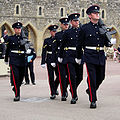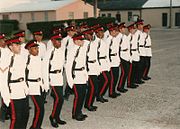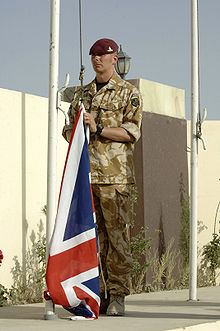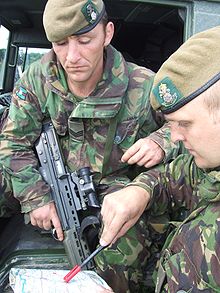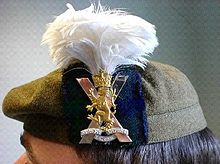- British Army uniform
-
British Army uniform currently exists in several grades, which are worn depending on the requirements of a unit or individual, ranging from ceremonial uniforms to combat dress.
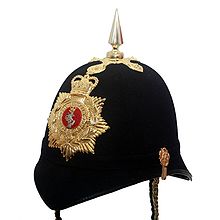 Full dress Home Service helmet, with the cap-badge of the Royal Electrical and Mechanical Engineers within the Brunswick star.
Full dress Home Service helmet, with the cap-badge of the Royal Electrical and Mechanical Engineers within the Brunswick star.
History
-
See also: Red coat (British army)
 Private of the 20th Regiment of foot from the Cloathing Book of 1742.
Private of the 20th Regiment of foot from the Cloathing Book of 1742.
By the end of the 17th century, England - soon to embrace Scotland to form Great Britain - had largely settled the standard colour of its army's uniforms: red. There were but a few exceptions.
In the decades following final victory over Napoleon in 1815, British army uniforms became increasingly flamboyant and impractical. This trend was curtailed by the realities of the Crimean War.
By the end of the 19th century the British army had moved over to khaki after experience in India. Dress uniform, however, particularly in the more fashionable regiments, could still be colourful to the point of peacockery.
The early use of camouflage - albeit plain khaki rather than variegated colours and patterns - reflected the exigencies of colonial war and the freedom allowed, and taken, by many of the officers who fought it. It is perhaps no coincidence that the increased use of khaki had a strong correlation with the increasing range of their opponents' weapons as technology progresses.
During the Second World War a handful of British units adopted camouflage patterned clothes such as the Airborne Forces' Denison smock and the windproof suit, in the late 1960s the DPM camouflage uniform was adopted across the whole of the British Army.
Uniform numbers
The British army numbers its uniforms for ease of instruction.[1] Fourteen 'orders' of dress are authorised and prescribed to be worn on various occasions; "Full Dress" is also prescribed for the most important ceremonies.
While there are officially fifteen different grades (or 'Numbers'), many of these are rarely worn or phased out altogether. Note that uniform distinctions can vary greatly from one Regiment or Corps to another, and the following descriptions are a generalisation.
Full Dress
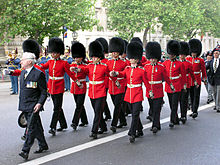 Soldiers of the Irish Guards in Full Dress. As with the other regiments of the Foot Guards, a tall Bearskin is worn.
Soldiers of the Irish Guards in Full Dress. As with the other regiments of the Foot Guards, a tall Bearskin is worn.
-
See also: Full dress
Full Dress is the most elaborate order worn by the British Army. It was withdrawn from general issue in 1914; the Household Division resumed wearing their scarlet full dress in 1920, but for the remainder of the Army, red coats were only authorised for wear by regimental bands and in mess dress or on certain limited social or ceremonial occasions. The reason for not generally reintroducing the distinctive full dress was primarily financial, as the scarlet cloth required expensive red cochineal dye.
Full dress is now rarely worn except by the Foot Guards and the Household Cavalry. It is issued at public expense to these units; other units may obtain and wear Full Dress (in their pre-1914 pattern if no modern order is prescribed) for use in historical displays, when acting as ushers or lining parties at weddings, and when acting as a sword guard to the Royal Horse Artillery.[2] However, these uniforms must be purchased and maintained from non-public funds.[3]
 Line infantry full dress: drummers of the Duke of Wellington's Regiment. The scarlet full dress tunic is of pre First World War pattern, while the headress is the dark blue cloth covered helmet introduced in 1878.
Line infantry full dress: drummers of the Duke of Wellington's Regiment. The scarlet full dress tunic is of pre First World War pattern, while the headress is the dark blue cloth covered helmet introduced in 1878.
In addition to the above, Full Dress is issued to Regular Army Bands for ceremonial use.[4] The cost of procuring and maintaining these uniforms is met by the Defence Clothing Integrated Project Team (DC IPT). The DC IPT is also responsible for maintaining the No. 3 dress which is usually worn by these ensembles whilst posted to warm-weather environments.[4]
 Full dress of the Household Cavalry: the Blues and Royals (left) and the Life Guards (right). Similar uniforms are worn by other heavy cavalry regiments.
Full dress of the Household Cavalry: the Blues and Royals (left) and the Life Guards (right). Similar uniforms are worn by other heavy cavalry regiments.
Each regiment or corps which commonly wears Full Dress prescribes its own unique style, approved by the Army Dress Committee.[5] They are generally a modified version of the pre-1914 uniforms. In the case of units created since the First World War, such as the Army Air Corps, the Full Dress order incorporates both traditional and modern elements.
Full Dress is worn whenever a parade is attended or ordained by the monarch or a member of the British Royal Family, including ceremonial parades, state funerals, and public duties around royal residences (such as the Changing of the Guard). It is worn by all members of the Household Division attending the Lord Mayor's procession, and also when participating in guards of honour or recruiting drives.[6]
No. 1: Temperate ceremonial uniform
See also: Dress uniform: British ArmyNo. 1 Dress, sometimes referred to as "blues", is a universal ceremonial uniform which is almost consistent throughout the British Army. No. 1 Dress is only worn on ceremonial occasions, and, in some regiments, by the duty officer. It is also regularly required to be worn by a short list of other units, senior staff officers (above the rank of Major-General), and officers appointed as aides to the Royal Family.[7] The order is not generally issued to all units, with the khaki No. 2 Dress functioning as the main parade uniform.
For most regiments and corps No. 1 dress consists of a dark blue tunic and trousers (or skirt) with a coloured peaked cap. Different units are distinguished by the colouring of the cap, piping on the tunic and of the welts or stripes on the trousers, as well as badges. There are some exceptions: the tunic and trousers of The Essex Yeomanry, The Rifles and Royal Gurkha Rifles are rifle green, while the Royal Dragoon Guards and the King's Royal Hussars wear dark green and crimson trousers respectively. Cavalry regiments wear shoulder chains in place of shoulder straps. Officers may wear a waist sash of crimson, silver and crimson silk, or a cross belt depending on the their regimental dress regulations and whether or not they are carrying a ceremonial sword. Other ranks wear a white buff or black leather belt with a regimental pattern locket, with a bayonet frog if carrying arms.
The peaked cap is not worn by all regiments; berets are worn in lieu by the Royal Tank Regiment, Army Air Corps, Parachute Regiment, Special Air Service and Intelligence Corps.[8] Berets are also worn by officers and other ranks of the Royal Regiment of Fusiliers and other ranks of the Royal Welsh in which feather hackles are displayed, recalling the plumes formerly worn on the full dress busby.[8] The Royal Regiment of Scotland wear a regimental glengarry with cockfeathers taken from the former ceremonial uniform of the Royal Scots and King's Own Scottish Borderers, the Royal Irish Regiment wear the caubeen, while the Brigade of Gurkhas wear a round Kilmarnock cap.[8]
The Royal Regiment of Scotland has a completely different No.1 pattern of tunic known as a "doublet" in Archer Green, worn with a kilt in regimental tartan.
-
Various patterns of No.1 dress being worn at the presentation of new colours to the Royal Military Academy Sandhurst
-
Soldiers of the Worcestershire and Sherwood Foresters Regiment in No.1 dress
-
Major-General Sir Evelyn John Webb-Carter in the No.1 dress uniform of the Duke of Wellington's Regiment[9]
-
The Bermuda Regiment has added red cuffs and collar to the No. 1 tunic.
No.2: Service dress (temperate parade uniform)
 Soldiers of the Royal Anglian Regiment in Number 2 Dress.
Soldiers of the Royal Anglian Regiment in Number 2 Dress.
Originally issued as a field uniform (see Service Dress (British Army)), this uniform is worn for most formal duties by all units. No.2 dress consists, for most corps and regiments, of a khaki jacket, shirt and tie with trousers or a skirt. Head dress is the same as that worn with No.1 dress, with the exception of the Brigade of Gurkhas, who wear the slouch hat and The Queen's Royal Hussars who wear their tent hat (the only head dress worn without a cap badge or other distinction). The Royal Regiment of Scotland wear a special pattern of jacket with a cut away front, worn with a regimental tartan kilt or trews. Coloured trousers are worn by some units: crimson by the King's Royal Hussars and dark green by the Royal Irish Regiment and Royal Dragoon Guards.
Officers are required to purchase their service dress, being provided with a Uniform Allowance to offset this and other uniform purchases. The pattern and material differs between Regiments: for instance the service dress of the Foot Guards and Honourable Artillery Company is darker that the 'standard', while the service dress worn by officers of 1st The Queen's Dragoon Guards is of "Bays" pattern cavalry twill.
Regimental distinctions worn on No.2 dress can include collar dogs (sometimes with coloured cloth backings), coloured lanyards worn on the shoulder, and arm badges. Regimental buttons are worn; for most units these are of gold or silver colour, with black buttons worn by The Rifles and Bronze by the Princess of Wales's Royal Regiment. Officers and Warrant Officers Class One wear a leather Sam Browne belt (that of 1st The Queen's Dragoon Guards is of pig skin which is not to be highly polished) or a cross belt. Infantry Warrant Officers Class Two and SNCOs wear a red sash over the right shoulder to the hip and Soldiers wear a white or black plastic waist belt with a plate buckle displaying the regimental badge.
Every regular army soldier is issued with one suit of No.2 dress. In general, issue of this order of dress to units of the Territorial Army is limited, with pools of khaki uniforms being held for use.[10]
No.3: Warm weather ceremonial uniform
No.3 dress is the warm weather equivalent of No. 1 dress worn in specified overseas stations. Formerly it comprised an all white high collared tunic and trousers worn with the coloured No.1 dress cap. Since the 1970s it has consisted of a white linen tunic, cut in a similar fashion to the No.1 dress jacket. Head dress, trousers, footwear and badges are generally as for No. 1 dress. Widely worn during the 1950s and 1960s (when Britain still maintained significant garrisons in tropical stations) this uniform is now usually restricted to military attaches and a few bands.
No.3 dress was typically issued temporarily, being withdrawn from the units on leaving the station. The band of the Royal Gibraltar Regiment is entitled to a permanent issue of No.3 dress.
For the Bermuda Regiment, however, No.3 dress is becoming the standard ceremonial uniform.[11] (the majority of public parades and events during which ceremonial dress is worn being during the summer months, reasons of economy are seeing No. 3 Dress gradually replacing No. 1 Dress on the few public occasions for which No. 1 Dress had been worn, such as the Peppercorn Ceremony).
No.4: Warm weather Service Dress (officers only)
Issued to officers on first posting to a warm weather area: the uniform is similar to No.2 dress but in a stone coloured polyester / woolen worsted mix. No.4 dress may be worn on formal occasions when not on parade with troops.
When officers are taking part in parades and formations with other ranks in warm weather areas, they wear either No.3 or No.6 dress.
No.5: Desert combat dress
Desert combat clothing is listed as: hat, jacket and trousers DPM and is issued to soldiers posted to Cyprus and the Middle East. As issued during the 1991 Gulf War, this uniform was identical to the No. 9 DPM tropical uniform, except for the multi-tone desert camouflage. This was quickly replaced with a two-tone DPM camouflage (the base colour and one other). Smocks were also available in the desert DPM, including the SAS pattern windproof smock. Covers for combat helmets and body armour were also made in this camouflage.
Formerly Battle Dress was designated as No.5 dress. This order of temperate combat dress was originally issued prior to the Second World War, becoming a smart barracks and walking-around dress with the introduction of green combat uniforms. It became obsolete in 1962, when replaced by No.2 Service Dress, which it had previously replaced as a combat uniform, and which had also been adapted as a smart uniform for barracks and parade use.
No.6: Warm weather parade uniform (bush jacket)
The "bush jacket" uniform (in Australia, this is known as the "safari uniform"). It consists of a tan bush-style 4-button jacket worn with or without a shirt and tie underneath and tan trousers. It is worn by all ranks for parades (as with No. 2 Dress), unless No. 3 dress is worn, and by ORs for all other occasions.
No.7: Warm weather barrack dress
The tropical shirt-and-trousers uniform, consisting of a tan long-sleeve shirt worn with tan "battle dress" trousers (kilt or trews for Scottish regiments), stable belt and regimental headgear.
No.8: Temperate combat dress
DPM Smock Windproof and trousers, temperate pattern.
DPM field jacket (smock) and trousers, worn with beret, helmet or camouflaged hat. The current system is known as Combat Soldier 95 (CS95)[12] system replaced the previous DPM No 8 and 9 Dress although older and specialist (e.g., the DPM Parachute Smock and Smock Windproof DPM) or private purchase items are often worn. In recent years, the British army has begun introducing Tactical Recognition Flashes - these are distinctive insignia worn on the arm of combat gear. TRFs denote the wearer's regiment or corps (or sub division thereof in the case of the AGC). The CS95 clothing system is designed to be lightweight, yet durable enough to be used throughout rigorous activities soldiers find themselves performing. It has also been designed with the idea that layers of clothing (referred to as onion skins) are much warmer and flexible than a singular thick layer. In addition to the shirt; a t-shirt, vest, combat jacket, shirt man's field ('Norgie' or 'Norwegian'), or Gore-Tex fabric waterproof jacket is worn dependent on weather, along with various types of gloves, underwear, trousers, all-in-one suits etc.
The layering system for the CS95 uniform is (as of 2008):
- Vest, mans, OG
- Jacket, Combat, Lightweight, Woodland DP (Lightweight Shirt)
- Trousers, Combat, Lightweight, Woodland DP (Combat trousers)
- Liner, DPM, Thermal (Fleece)
- Liner, DPM, MVP (Gore-Tex Fabric Jacket)
- Jacket, DPM, Field (Combat Jacket)
- Trousers, Mans, DPM, MVP (Gore-Tex Fabric Trousers)
- UBACS (Under Body Armour Combat Shirt) A new issue item in Afghanistan and Iraq. Made of coolmax fabric.
Working headress is normally worn, which is typically a beret. The colour of the beret usually shows what type of regiment the wearer is from. The colours are as follows:
- Khaki—Foot Guards, Honourable Artillery Company, Princess of Wales's Royal Regiment, Royal Anglian Regiment, Duke of Lancaster's Regiment, Royal Welsh, Yorkshire Regiment, Royal Gibraltar Regiment, 4/73 (Sphinx) Special Observation Post Battery RA[13]
- Light grey—Royal Scots Dragoon Guards
- Dark grey—Queen Alexandra's Royal Army Nursing Corps
- Brown—King's Royal Hussars, Royal Wessex Yeomanry
- Black—Royal Tank Regiment, W (Westminster Dragoons) Squadron, Royal Yeomanry
- Dark (Rifle) green—The Rifles, Royal Gurkha Rifles, Small Arms School Corps, Essex Yeomanry
- Maroon—Parachute Regiment, All ranks serving with 16 Air Assault Brigade other than the non Parachute Regiment Infantry Battalion (note that the beret is not restricted to Parachute qualified personnel).
- Beige—Special Air Service including attached troops who are not SAS-qualified
- Emerald grey - Special Reconnaissance Regiment
- Commando Green - Commando qualified personnel serving in Commando units (e.g. Royal Marines or the Special Boat Service)
- Cypress Green - Intelligence Corps
- Sky blue—Army Air Corps
- Scarlet—Royal Military Police
- Green—Adjutant General's Corps (except Royal Military Police, who wear scarlet; Military Provost Staff and Army Legal Service, who wear navy blue), Military Provost Guard Service
- Navy blue—all other Army units (except Scottish line infantry regiments and the Royal Irish Regiment).
Troops from other services, regiments or corps on attachment to units with distinctive coloured berets often wear those berets (with their own cap badge). Colonels, brigadiers and generals usually continue to wear the beret of the regiment or corps to which they used to belong with the cap badge distinctive to their rank. The Royal Regiment of Fusiliers, the only remaining independent fusilier regiment, wears a feather hackle on the beret. Other ranks of the Royal Welsh also wear hackles.
The Royal Regiment of Scotland and Royal Irish Regiment, instead of the beret, wear the tam o'shanter and the caubeen respectively.
The beret will often be replaced with the Combat Helmet, covered in DPM material. However, in jungle conditions, the helmet is often replaced with a DPM bush hat - or equally in cold conditions, a DPM peaked hat (Cap, Extra Cold Weather), a rolled woollen tube known as a cap comforter, or other specialised headgear. When the British Army finds itself in peacekeeping roles, regimental headress is worn (where the tactical situation allows) in preference to the helmet or DPM hat, in order to appear less hostile to local civilians. This tactic was used in the Troubles in Northern Ireland, and today can be seen in some areas of southern Iraq.
Some Regiments and Corps wear a stable belt in No 8 dress whilst others restrict its use to Nos 13 and 14 Dress. The stable belt is a wide belt, made of a tough woven fabric. It is traditionally fastened with a set of leather straps and buckles on the wearer's left hand side (in some units to their front), but may alternatively have a metal locket arrangement, or a plate at the front bearing regimental, or formation insignia. The fabric of the belt itself is in regimental colours, either a single colour or striped along its length. The stable belt dates back to a time when soldiers in mounted, or horse drawn units wore similar belts that were often fitted with pockets to carry fob watches and loose change whilst looking after the horses. It has since become much more formalised and not restricted to cavalry units.
On exercises and operations the stable belt replaced with a plain green field belt. Synthetic Personal Load Carrying Equipment has replaced webbing. This has numerous components which can be assembled to meet the soldier's requirements and preference.
The woollen pullover (jumper, sweater or Woolly Pully) has been used for several decades and originally each soldier was issued with two. However, despite its popularity (it has also been adopted by police services, and by many foreign military forces including the US Marine Corps) in the CS95 system, one pullover has been replaced by a 'Liner, thermal', which is not intended to be worn as an outer garment.
No.9: Tropical Combat Dress
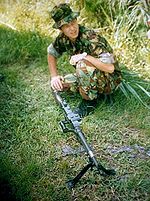 A Bermuda Regiment Warrant Officer in No.9 Dress.
A Bermuda Regiment Warrant Officer in No.9 Dress.
No.9 dress is no longer provided, being replaced by Combat Soldier 95 No 8 Dress. Made from cotton or poly-cotton DPM material of a lighter weight than pre-Combat Soldier 95 No 8 Dress The jacket was similar in cut to a shirt and had epaulettes fitted to the shoulders. Its sleeves could be rolled above the elbow and the shirt tucked into the trousers for a smarter appearance for example in barracks. There is a large pocket on each breast, closed with a button-down flap, and a first field dressing pocket on one sleeve. This uniform was normally worn with a DPM bush hat; out of the field, regimental headdress was often worn.
The trousers had button down belt loops, when carrying equipment was not worn, a uniform belt was worn in these loops.
The tropical combat trousers and shirt were preferred by many in the British military for wear on exercise in the UK and Northern Europe, due to their ability to dry very quickly when wet.[citation needed] Some units such as the Parachute Regiment, still prefer their use in the field over CS95 clothing.[citation needed]
No.10: Temperate mess dress
Main article: Mess dressShort Jacket, with which men wear trousers, overalls or a kilt, and women a long dress or skirt. Normally worn by the rank of Sergeant upwards for formal functions, its colours and pattern can vary greatly from unit to unit but generally match the traditional full dress of the regiment or corps. Thus jackets can be scarlet, dark blue or green with facings and waistcoats in regimental colours.
No.11: Warm weather mess dress
A white jacket is substituted for the coloured one of temperate mess dress. Waistcoats are not worn.
No.12: Protective clothing
Formerly olive green shirt and trousers, it has been replaced with smart Combat Dress: ironed shirt and trousers worn with beret and stable belt (identical to that of No. 7 Dress). The current uniform worn by soldiers most of the time, it is to be supplemented by the new Barrack Dress.
No.13: Temperate barrack dress
Khaki Barrack dress trousers (as issued under the Future Army Dress (FAD) programme) and the khaki shirt from No.2 dress with pullover and stable belt. Some regiments' officers and WOs may wear coloured pullovers in place of the green pattern; the following regimental patterns and colours are authorised:[14]
- Grey/blue v-neck: Royal Scots Dragoon Guards
- Grey/blue/green knit: Queen's Royal Lancers
- Grey/brown v-neck: 1st The Queen's Dragoon Guards
- Grey/green v-neck: Royal Regiment of Fusiliers
- Grey v-neck: Queen Alexandra's Royal Army Nursing Corps
- Green v-neck: Princess of Wales's Royal Regiment, 307 (South Nottinghamshire Hussars Yeomanry) Battery RA (V)
- Lincoln green v-neck: 68 (Inns of Court and City Yeomanry) Signal Squadron (V)
- Pale green v-neck: Royal Dragoon Guards
- Dark green: Queen's Royal Hussars
- Emerald green v-neck: Royal Army Dental Corps
- Brunswick green v-neck: 9th/12th Royal Lancers
- Lovat green v-neck: Royal Yeomanry
- Green fleck v-neck: Royal Wessex Yeomanry
- Lovat green and red fleck v-neck: 70 (Essex Yeomanry) Signal Squadron (V)
- Black: Royal Tank Regiment, Royal Army Chaplains Department, Army Legal Services Branch[15]
- 265 (Kent and County of London Yeomanry) Support Squadron (V)
- Navy/corvette blue: Royal Artillery
- Dark blue: 94 (Berkshire Yeomanry) Signal Squadron (V)
- Dark blue v-neck: A (London Scottish) Company, The London Regiment
- Storm blue v-neck: Queen's Own Yeomanry
- Light blue/green fleck: Light Dragoons
- Maroon: Royal Army Veterinary Corps
- Dull cherry v-neck: Royal Army Medical Corps
- Brown/crimson with brown shoulder and elbow pads: King's Royal Hussars
- Buff: Mercian Regiment
- Mid brown v-neck: Royal Mercian and Lancastrian Yeomanry
The pullover is used in other colours by the other services (navy blue for the Royal Navy, and blue-grey for the Royal Air Force).
A regimental pattern coloured side hat (officially described as a cap field service) may be worn at the commanding officer's discretion.
No.14: Shirt Sleeve Order
As for No.13, but with the shirt sleeves rolled up to above elbow level (or short sleeve shirt in the new Future Army Dress (FAD) barrack dress). The pullover is not worn.
No.15: Blue Patrols
An undress uniform worn on semi-formal occasions by officers and Regimental Sergeants Major of the Royal Regiment of Scotland. No 15 dress consists of a blue patrol jacket, tartan trews and Glengarry head dress.[16]
See also
- Battledress
- Battle Dress
- Denison Smock
- Stable belt
- Canadian Para Smock
- Smock Windproof DPM
- DPM Parachute Smock
- Red coat (British army)
- Military uniform
- Mess dress
- Modern equipment of the British Army
External links
References
- ^ British Army Dress Committee (August 2005). Joint Service Publication 336: The Defence Supply Chain Manual. Vol. 12, Part 3, Pamphlet 3, Sect. 1 (3rd edition ed.). http://web.archive.org/web/20071106000709rn_1/www.aof.mod.uk/content/docs/jsp336/3rd_ed/vol12/pt3/pam3/s1.doc. Retrieved 2008-07-29.
- ^ British Army Dress Committee (August 2005). Joint Service Publication 336: The Defence Supply Chain Manual. Vol. 12, Part 3, Pamphlet 12, Sect. 1 (3rd edition ed.). p. Para. 116. http://web.archive.org/web/20071106000709rn_1/www.aof.mod.uk/content/docs/jsp336/3rd_ed/vol12/pt3/pt3/pam12/s1.doc. Retrieved 2008-07-29.
- ^ British Army Dress Committee (August 2005). Joint Service Publication 336: The Defence Supply Chain Manual. Vol. 12, Part 3, Pamphlet 12, Sect. 1 (3rd edition ed.). p. Para. 104. http://web.archive.org/web/20071106000709rn_1/www.aof.mod.uk/content/docs/jsp336/3rd_ed/vol12/pt3/pam12/s1.doc. Retrieved 2008-07-29.
- ^ a b British Army Dress Committee (August 2005). Joint Service Publication 336: The Defence Supply Chain Manual. Vol. 12, Part 3, Pamphlet 12, Sect. 1 (3rd edition ed.). p. Para. 117, 119. http://web.archive.org/web/20071106000709rn_1/www.aof.mod.uk/content/docs/jsp336/3rd_ed/vol12/pt3/pam12/s1.doc.
- ^ British Army Dress Committee (August 2005). Joint Service Publication 336: The Defence Supply Chain Manual. Vol. 12, Part 3, Pamphlet 12 (3rd edition ed.). http://web.archive.org/web/20071106000709rn_1/www.aof.mod.uk/content/docs/jsp336/3rd_ed/vol12/pt3/pt3/pam12/contents.htm. Retrieved 2008-07-29.
- ^ British Army Dress Committee (August 2005). Joint Service Publication 336: The Defence Supply Chain Manual. Vol. 12, Part 3, Pamphlet 12, Sect. 1 (3rd edition ed.). p. Para. 105. http://web.archive.org/web/20071106000709rn_1/www.aof.mod.uk/content/docs/jsp336/3rd_ed/vol12/pt3/pam12/s1.doc. Retrieved 2008-07-29.
- ^ British Army Dress Committee (August 2005). Joint Service Publication 336: The Defence Supply Chain Manual. Vol. 12, Part 3, Pamphlet 3, Sect. 3 (3rd edition ed.). p. Para. 313. http://web.archive.org/web/20071106000709rn_1/www.aof.mod.uk/content/docs/jsp336/3rd_ed/vol12/pt3/pam3/s3%20.doc. Retrieved 2008-07-29.
- ^ a b c British Army Dress Committee (August 2005). Joint Service Publication 336: The Defence Supply Chain Manual. Vol. 12, Part 3, Pamphlet 15 (3rd edition ed.). p. Annex A. http://web.archive.org/web/20071106000709rn_1/www.aof.mod.uk/content/docs/jsp336/3rd_ed/vol12/pt3/pam15/s5aa.doc. Retrieved 2008-07-29.
- ^ He is wearing Colonel's (not Maj Gen's) Rank as he is in his uniform as the Colonel of The Regiment
- ^ The Defence Supply Chain Manual, JSP 336 (3rd Edition), Volume 12, Pamphlet 7, Clothing regulations and scales Territorial Army (all ranks)
- ^ "Dress Regulations". Bermuda Regiment. http://www.bermudaregiment.bm/Dress_Regulations.html.
- ^ THE DEFENCE SUPPLY CHAIN MANUAL JSP 336 (3rd Edition) VOLUME 12 PART 3 PAMPHLET 5 SECTION 4 COMBAT SOLDIER 95 (CS 95) - THIS DOCUMENT HAS BEEN REORDERED BY MOD AND IS NOW JSP883 Vol6 Part5 Dated 1 Sep 2004
- ^ "Yorkshire Gunners honoured for Service in Iraq and Afghanistan". Ministry of Defence. http://www.mod.uk/DefenceInternet/DefenceNews/HistoryAndHonour/YorkshireGunnersHonouredForServiceInIraqAndAfghanistan.htm. "Earlier in the day, in what marks a historic change in the history of one of the Batteries from the Regiment - 4/73 (Sphinx) Battery, the traditional dark blue beret of the Royal Artillery was replaced with a khaki-coloured beret. The change came about as a result of the Battery working closely, in times of war, with the Honourable Artillery Company"
- ^ Material Regulations for the Army, Volume 3, Pamphlet 16, Optional Items of Dress (Note that Mat Regs have now been replaced by JSP336 so this reference is no longer current)
- ^ AGC PRI shop - Black ALS woollen jumper http://www.shopagc.co.uk/shopdisplayproducts.asp?id=55&cat=Clothing
- ^ Royal Regiment of Scotland Dress Regulations, accessed April 28, 2008
Categories:- British military uniforms
- British Army equipment
-
Wikimedia Foundation. 2010.


